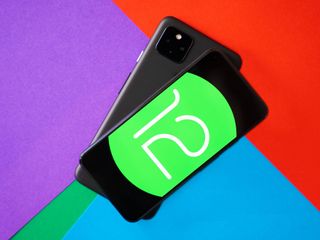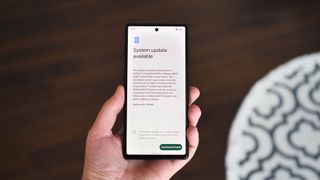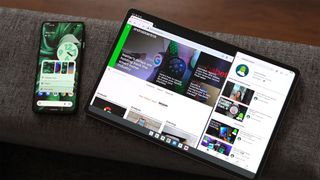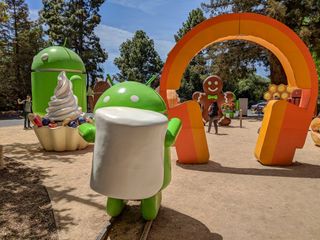From the Editor's Desk: Why are there so many Android betas?
12L? QPR3? WTF?

Android 12 QPR 3 Beta 1 is not a soccer scoreline, but the next release of Android 12, following the recent launch of Android 12L on some Pixel devices earlier this month. If you're slightly confused, you're not alone. It seems like there's an alphabet soup of different Android 12 varieties to choose from right now, especially when it comes to beta and pre-release builds.
First, there's Android 12 itself, which was released last October and has been rolling out to various phones over the past few months.
There's Android 12L, which was pitched as an update mainly for big screens but also recently rolled out to some Pixel phones as the "March Feature Drop".
And now there's the new Android 12 QPR3, which stands for Quarterly Platform Release 3 and is available to test through the Android beta program ahead of its launch in June alongside the next Google Pixel "Feature Drop."
In any of those cases, though, if you look under System > About phone on any device running either baseline Android 12 or 12L, or even the new Android 12 QPR3 — you'll just see "Android 12." Google doesn't offer any detail about which precise flavor of Android 12 you're running.
What does this all mean?

The problem here doesn't really have to do with the software itself but the opaqueness of the branding surrounding it. Given the messaging from Google, a lot of people might assume Android 12L is just for tablets and foldables — a separate branch of Android for these devices similar to the old tablet-exclusive Android 3.0 Honeycomb.
"QPR3" also implies the existence of earlier Quarterly Platform Releases — so if this latest beta build really is the third QPR for Android 12 then what happened to the first two? And is this "QPR" continuation of Android 12L or is it a separate branch of Android 12? From branding, it's not at all clear.
Be an expert in 5 minutes
Get the latest news from Android Central, your trusted companion in the world of Android
Google (sorta) explains what's going on in this statement on its official developer site:
"Following the stable release of Android 12 to AOSP, we continue to update the platform with fixes and improvements that are then rolled out to supported devices. These releases happen on a quarterly cadence through Quarterly Platform Releases (QPRs), which are delivered to AOSP and to Google Pixel devices as part of Feature Drops."
In the past, Google quietly worked away on QPRs for previous Android versions like Android 11, 10, and 9 without much public fanfare. (And before that, in older versions like Android Oreo, they were called maintenance releases — MRs — and weren't tied to a quarterly schedule).
So QPRs aren't new. But the fact that Google's testing them publicly is new — and probably not a bad thing considering the relatively buggy state of early Android 12 builds. On Google's latest handsets in particular, an embarrassing cavalcade of software faults resulted in the first major software update for the Pixel 6 being pulled in late 2021, leaving users on an older build with a different (though less serious) menagerie of bugs until mid-January 2022.
By publicly testing the third Quarterly Platform Release for Android 12 a few months ahead of launch, Google will hope to avoid a repeat of that situation.
As for the outstanding first and second Quarterly Platform Releases of Android 12, turns out they do actually exist.
As Esper's Mishaal Rahman explains on Twitter, QPR1 was the big Android 12 bug-fix update that landed in December — the one that was ultimately halted on Pixel 6 phones due to outstanding bugs. QPR2 was the recently-launched Android 12L — which contained several minor updates for phones alongside its widely publicized tablet and foldable features.

There's no fragmentation going on here — Android 12L contains everything that was already in that December patch. And QPR3 includes everything in Android 12L.
A couple of unusual things are going on, though: First, Google's actually talking about QPRs now and letting Pixel owners test them months ahead of release. And second, we've had the anomaly of Android 12L combining the second QPR with a bunch of new tablet and foldable features and new APIs for developers.
A look back to the past

To further demystify this stuff, let's look back to how Android releases used to be numbered, before we had Ls and QPRs. Android had a decimalized version number similar to a lot of other kinds of software.
Major Android versions are the ones that used to get sweet treat nicknames — the big annual Android releases with a bunch of new user-facing features and new APIs for developers that let apps do new things. They'd typically arrive in late summer and be accompanied by a new Nexus or Pixel phone — think Android 6.0, 7.0, or 8.0.
Then sometimes you'd have point releases — like Android 5.1, 5.2, or 7.1. These weren't a huge deal in terms of new user-facing features, but they did introduce new APIs for developers. New APIs tended to mean bumping the version number by 0.1.
Finally, there were minor Android updates like Android 5.1.1 or 7.1.1 — usually small bug fix updates that changed a few things behind the scenes but didn't introduce new APIs or anything as large in scope as a full point release.
If Google was still numbering Android releases in this way, things would have shaken out as follows:
- Baseline Android 12 would, obviously, be Android 12.0.
- Then that first big December 2021 bug fix update, QPR1, would've been Android 12.0.1.
- Android 12L, with its new APIs for tablets and foldables, would've been Android 12.1.
- And then Android 12 QPR3, which doesn't include any new APIs, would've eventually come along as Android 12.1.1.

The old numbered releases give a better idea of what's going on behind the scenes, and how big of a deal each subsequent version is. But they also give the impression that, once a point release comes along, the original release is old. That's not really the case, especially since we now have monthly Android security patches that arrive independently of whichever Android version your device might be running.
That's probably a big part of why you just see "Android 12" now when you look at the version number on your phone's "About" screen. Google doesn't want you to get too hung up on anything besides which major, annual release of the OS you're running. (And, of course, the Android security patch date).
With the arrival of public betas for Android QPR builds, we're moving towards three software "channels" for Pixel phones. Like Google Chrome and Chrome OS, these offer varying levels of stability depending on how quickly you want to play with new stuff.
- First, you have developer preview builds — the stage Android 13 is currently at, where you can expect things to be early and potentially pretty broken. These need to be flashed manually, so they're aimed at tech-savvy users, engineers, and developers.
- In the middle, there's the Android beta program, aimed at a more general audience. It's still technically pre-release, but things like Google Pay and DRM still work, and you get to play with new Android features up to three months early.
- And then there are the stable builds, which the vast majority of Pixel phones will be running.
So what's next for Android?
The new Android 12 QPR3 beta gives Android fans a chance to test the next minor update to the OS ahead of launch with the June Feature Drop in a few months. This version is the successor to Android 12L, and will eventually be succeeded by Android 13. Once that launches, expect beta testing of Android 13 QPR1 to begin in earnest towards the end of 2022, followed by QPR2 in early 2023. This will likely be the new normal cadence for Android beta releases.
All of which should mean future Android versions will be a lot more stable on the best Android phones of the day — especially compared to the early days of Android 12. By getting more eyeballs on the next QPR months ahead of launch, Google will also hope to never again have to withdraw a big software update from devices, as it did with QPR1 for the Pixel 6 back in December.
While the branding may be somewhat confusing, more beta testing means a more stable Android going forwards.

Alex was with Android Central for over a decade, producing written and video content for the site, and served as global Executive Editor from 2016 to 2022.
